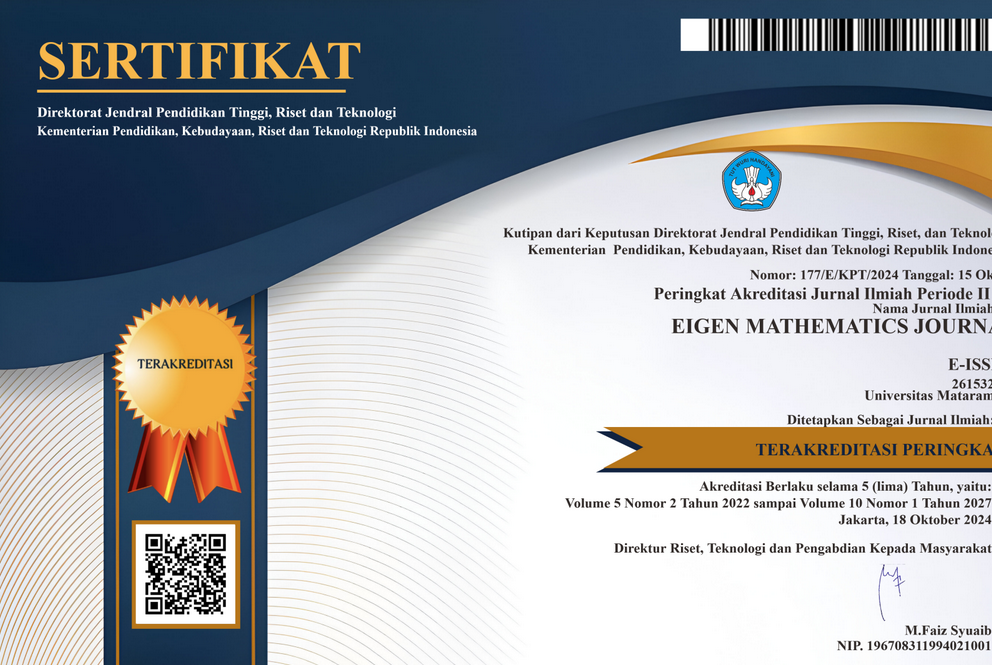Penerapan Model Vector Autoregressive Integrate Moving Average dalam Peramalan Laju Inflasi dan Suku Bunga di Indonesia
DOI:
https://doi.org/10.29303/emj.v3i2.62Keywords:
Akaike’s Information Criterion (AIC), Mean Absolute Percentage Error (MAPE), Multivariate time series, VARIMAAbstract
The inflation and interest rates in Indonesia have a significant impact on the country's economic development. Indonesian inflation and interest rates data are multivariate time series data that show activity over a certain period of time. Vector Autoregressive Integrated Moving Average (VARIMA) is a method for analyzing multivariate time series data. This method is a simultaneous equation modeling that has several endogenous variables simultaneously. This study aimed to model the inflation and interest rates data, from January 2009 to December 2016 and predict inflation and interest rates by using VARIMA method. The model obtained was the VARIMA(0,2,2) model, with estimated parameters using the maximum likelihood method. The choice of the VARIMA(0,2,2) model was based on the smallest AIC value of -4,2891, with a MAPE value for the inflation and interest rates forecasting were 6,04% and 1,84%, respectively, which indicates a very good forecast results.References
Bain L.J.dan Engelhardt, M.(1992). Introduction to Probability and Mathematical Statistics. California: Duxbury Press.
Bank Indonesia (BI). (2016).Informasi Dasar Suku Bunga. http://www.bi.go.id/. Diakses pada Januari 2019.
Draper, N. R. dan Smith, H. (1998)Applied Regression Analysis 3rdEdition. United States of America: John Wiley and Sons.
Hermayani, Nohe, D.A., dan Fathurahman, M. (2014). Mengatasi Heteroskedastisitas pada Model ARIMA Menggunakan ARCH-GARCH (Studi Kasus: IHK Provinsi Kalimantan Timur Tahun 2005-2012).Jurnal Eksponensial, 5(1), 73 – 81.
Makridakis, S., Wheelwright, S., dan McGee, V. (1999). Metode dan Aplikasi Peramalan, Jilid 1 Edisi Kedua Terjemahan Ir. Untung S. Andriyanto dan Ir. Abdul Basith.Jakarta: Penerbit Erlangga.
Mankiw, N. G. (2007). Teori Makroekonomi Edisi Keenam. Jakarta: Erlangga.
Matjik,A.A. danSumertajaya, I. M. (2011).Sidik Variabel Ganda dengan Menggunakan SAS. Bogor: IPB PRESS.
Rinaldy, R. (2016). Analisis Peramalan Data Runtun Waktu Menggunakan Vector Autoregressive Integrated Moving Average (VARIMA), SkripsiJurusan Matematika Fakultas Matematika dan Ilmu Pengetahuan Alam, Universitas Lampung.
Sukirno, S. (2008). Teori Pengantar Ekonomi Makro.Jakarta: Raja Grafindo Persada.
Sunariyah. (2014). Pengantar Pengetahuan Pasar Modal Edisi Kelima.Bandung: CV Alfabeta.
Wei, W. W. (2006). Time Series Analysis: Univariate and Multivariate Method.USA: Pearson Educations.
Zainun, N.Y. dan Majid,M.Z.A. (2003). Low Cost House Demand Predictor.Malaysia: Universitas Teknologi Malaysia.
Downloads
Published
How to Cite
Issue
Section
License
All articles published in the Eigen Mathematics Journal will be available for free reading and downloading. The license applied to this journal is Creative Commons Attribution-Non-Commercial-Share Alike (CC BY-NC-SA).
Most read articles by the same author(s)
- Aditya Setyawan R, Mustika Hadijati, Ni Wayan Switrayni, Analisis Masalah Heteroskedastisitas Menggunakan Generalized Least Square dalam Analisis Regresi , EIGEN MATHEMATICS JOURNAL: Vol. 2 No. 2 Desember 2019
- Ni Luh Putu Dewi Wikayanti, Qurratul Aini, Nurul Fitriyani, Pengaruh Kurs Dolar Amerika Serikat, Inflasi, dan Tingkat Suku Bunga Terhadap Indeks Harga Saham Gabungan Dengan Vector Error Correction , EIGEN MATHEMATICS JOURNAL: Vol. 3 No. 1 Juni 2020
- Himayati Himayati, Ni Wayan Switrayni, Desy Komalasari, Nurul Fitriyani, Analisis Rotasi Ortogonal pada Teknik Analisis Faktor Menggunakan Metode Procrustes , EIGEN MATHEMATICS JOURNAL: Vol. 3 No. 1 Juni 2020
- Nirwana Nirwana, Mustika Hadijati, Nurul Fitriyani, Estimasi Parameter Model Moving Average Orde 1 Menggunakan Metode Momen dan Maximum Likelihood , EIGEN MATHEMATICS JOURNAL: Vol. 1 No. 1: Juni 2018
- Moudy Puspita Ayudhiah, Syamsul Bahri, Nurul Fitriyani, Peramalan Indeks Harga Konsumen Kota Mataram Menggunakan Vector Autoregressive Integrated Moving Average , EIGEN MATHEMATICS JOURNAL: Vol. 3 No. 1 Juni 2020
- Ulfa Destiarina, Mustika Hadijati, Desy Komalasari, Nurul Fitriyani, Estimasi Parameter Distribusi Mixture Eksponensial dan Weibull dengan Metode Bayesian Markov Chain Monte Carlo , EIGEN MATHEMATICS JOURNAL: Vol. 2 No. 1 Juni 2019
- Deni Pratiwi, Lalu Abd Azis Mursy, Muhammad Rizaldi, Nurul Fitriyani, Regresi Nonparametrik Kernel Gaussian pada Pemodelan Angka Kelahiran Kasar di Provinsi Nusa Tenggara Barat , EIGEN MATHEMATICS JOURNAL: VOL. 3 NO. 2 DESEMBER 2020
- Nurul - Insan, Mustika Hadijati, Irwansyah Irwansyah, Perbandingan Metode Classification and Regression Trees (CART) dengan Naïve Bayes Classification (NBC) dalam Klasifikasi Status Gizi Balita di Kelurahan Pagesangan Barat , EIGEN MATHEMATICS JOURNAL: Vol. 3 No. 1 Juni 2020
- Bidayani Bidayani, Mustika Hadijati, Nurul Fitriyani, Model Regresi Semiparametrik Spline Hasil Produksi Padi di Kabupaten Lombok Timur , EIGEN MATHEMATICS JOURNAL: Vol. 2 No. 1 Juni 2019
- Baiq Urfa Justitiaski, Nurul Fitriyani, Syamsul Bahri, Modeling the Number of Infant Mortality in East Lombok using Geographically Weighted Poisson Regression , EIGEN MATHEMATICS JOURNAL: Vol. 5 No. 2 Desember 2022






